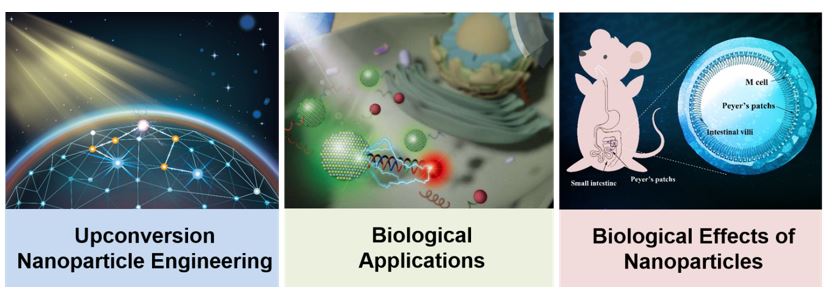Video Article Open Access
Lanthanide Nanocrystal Engineering
Qianqian Su
Institute of Nanochemistry and Nanobiology, Shanghai University, Shanghai 200444, China
Vid. Proc. Adv. Mater., Volume 3, Article ID 2211376 (2022)
DOI: 10.5185/vpoam.2022.11376
Publication Date (Web): 27 Nov 2023
Copyright © IAAM
Graphical Abstract

Abstract
Nanomaterial engineering plays a vital role in the regulation of many material properties. Upconversion materials that convert low energy excitation wavelength to high energy emission have attracted considerable attention due to the advantages of high penetration depth and high resistance to autofluorescence interference capability. However, upconversion remains a daunting challenge due to low quantum efficiency. We present rational designs and synthesis of upconversion nanoparticles with careful control of these nanoparticles' surface and interface, resulting in remarkable optical properties. We realize the intense six-photon-upconverted UV emissions at 253 nm under 808 nm excitation. We also observe largely enhanced and extended lanthanide emissions in the visible and near-infrared ranges. We believe that our demonstration will provide a major step towards the precise control of lanthanide luminescence and will offer tantalizing opportunities for various applications. Moreover, by taking advantage of lanthanide nanoparticles, we demonstrated that nanoparticles can traverse the blood–brain barrier, endocytose into the lysosomes of glioblastoma cells, and undergo endolysosomal escape upon photochemical ionization. An optimal dose of metronomic chemotherapy using dual-drug-loaded nanocarriers can induce an augmented antitumor effect directly on tumors.
Furthermore, the toxicity and the localization of these upconversion nanoparticles was studied. Our study showed low toxicity of lanthanide nanoparticles. However, we found that a high percentage of nanoparticles accumulate and sequester in the liver after intravenous administration into the body. In comparison, nanoparticles can cross the small intestine through oral administration uptake by Peyer’s patches and accumulate in bone. This results in reduced delivery to the targeted diseased tissue and potentially leads to increased toxicity at the hepatic and osseous cellular levels. Interestingly, we demonstrate the molecular upconversion luminescent probe, which shows excellent photostability, high quantum yield and rapid excretion capability. The NIR-to-NIR upconversion technique also offers a promising detection method, which shows very high sensitivity and selectivity for detecting Cu2+ ions in vitro and in vivo. To sum up, current research shows that lanthanide nanoparticles have potential in the biomedical field. But, the development of advanced nanomaterials with ultrasmall size/superior optical properties and a better understanding of how nanomaterials affect biological systems are needed.
Keywords
Upconversion luminescence enhancement; nanocrystal engineering; bioapplications; toxicity.
Acknowledgement
The authors thank the National Natural Science Foundation of China (No. 21701109) and the National Basic Research Program of China (No. 2016YFA0201600). The authors thank Prof. X. Liu, Prof. D. Jin, Prof. F. Wang, Prof. S. Han and Prof. X. Qin for helpful discussions.
References
- Q. Su, H.L. Wei, C. Chen, M. Guan, S. Wang, Y. Su, H. Wang, Z. Chen, D. Jin, Nature Communications, 2021, 12, 4367.
- J. Y. M. Ang, J. Yoon, M. Zhou, H.-L. Wei, Y. Y. Goh, K. Lok, Y. Liu, Z. Li, H. Wang, Q. Su, S. T. D. Ong, X. Liu, Advanced Materials, 2022, 34, 2106194.
- Y. Liu, Q. Su, M. Chen, Y. Dong, Y. Shi, W. Feng, Z. Wu, F. Li, Advanced Materials, 2016, 28, 6625.
- Q. Su, S. Han, X. Xie, H. Zhu, C.K. Chen, R.S. Liu, X. Chen, F. Wang, X. Liu, Journal of the American Chemical Society, 2012, 134, 20849. (ESI Highly Cited Papers)
- M. Zhou, X. Zou, Y. Liu, H. Wang, Q. Su, New Journal of Chemistry, 2022, 46, 8752.
Biography
Qianqian Su received her BE degree from Shandong University. She received her MS degree from Guangzhou Institute of Chemistry, Chinese Academy of Sciences and completed her PhD degree under the supervision of Professor Xiaogang Liu at National University of Singapore. She worked as a research fellow at Fudan University with Professor Fuyou Li. She then worked as a visiting scholar and senior visiting scholar at National University of Singapore, University of Technology Sydney and Genome Institute of Singapore. She joined Institute of Nanochemistry and Nanobiology at Shanghai University in 2017 and worked as a Principal Investigator in 2021. Her research interests focus on the development of novel luminescent nanomaterials for biomedical applications. Dr. Su has authored 8 patents and 50 peer-reviewed scientific journals (total citation > 4100, Google Scholar), including J. Am. Chem. Soc., Adv. Mater., Nat. Commun, Acc. Chem. Res, etc., 6 of which were selected as Highly Cited Papers in ESI.
Video Proceedings of Advanced Materials

Upcoming Congress



